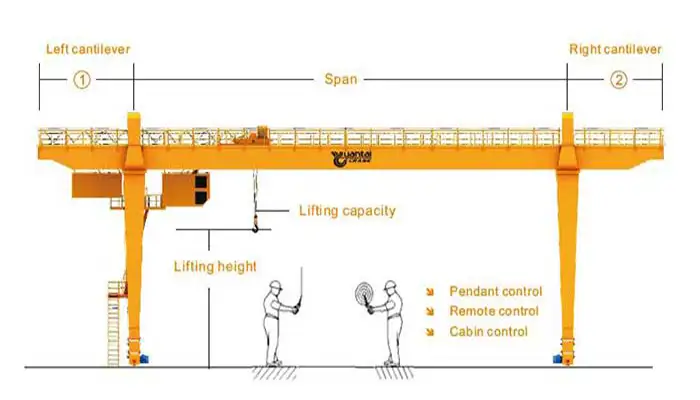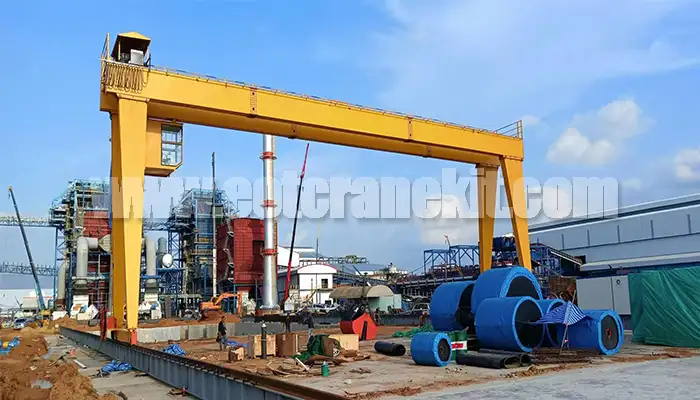
Custom Gantry Cranes for Diverse Ash Handling Requirements
Custom gantry cranes enhance ash handling efficiency, accommodating various ash types with tailored designs for safety, precision, and operational flexibility.
Ash handling is a crucial process in many industries, especially in power generation and waste management. When coal is burned, it produces ash that needs to be safely transported and disposed of. Handling this ash efficiently can prevent potential hazards, protect the environment, and enhance overall operational efficiency.
Now, this is where custom gantry cranes come into play. Unlike standard cranes, these tailored solutions can meet the specific demands of your operation. They can lift heavy ash loads, navigate tight spaces, and endure harsh conditions, ensuring that your ash handling process runs smoothly. Trust me, investing in the right equipment can save you time and money in the long run.
In this article, we’ll delve into the various aspects of custom gantry cranes designed for diverse ash handling requirements. Whether you’re new to the field or looking to optimize your existing processes, you'll find valuable insights here. We’ll share practical tips, key design considerations, and even real-world examples to help you make informed decisions. Let’s get started!
Ash Handling Requirements
Types of Ash Generated
As for ash handling, it's essential to recognize the different types of ash produced during combustion processes. Fly ash is a lightweight, fine powder that is carried away with flue gases during combustion. Its fine texture can make it tricky to manage, often requiring specialized equipment to prevent dust and ensure safe handling.
On the other hand, bottom ash is much heavier and collects at the bottom of the combustion chamber. This coarser material tends to be more straightforward to handle but requires robust systems to manage its weight and volume effectively.
These differences is key to effective management. Each type of ash not only has unique physical properties but also demands distinct handling methods and equipment tailored to its characteristics. By recognizing these variations, you can develop strategies that optimize the efficiency and safety of your ash handling operations.
Challenges in Ash Handling
Handling ash isn’t without its challenges. One of the primary issues is the abrasive nature of ash, which can wear down equipment over time. This wear and tear often leads to costly repairs or even replacements, which can disrupt operations and impact your bottom line.
Another significant challenge is managing dust. Ash can easily become airborne, creating safety hazards for workers and posing environmental concerns. Controlling dust is crucial not only for compliance with regulations but also for maintaining a safe and healthy workplace.
To tackle these issues, it's vital to implement solutions that effectively transport ash while also controlling dust and minimizing environmental impact. Reliable systems—like custom gantry cranes with integrated dust control features—can save you a lot of frustration down the line. Investing in the right equipment and strategies upfront can lead to smoother operations and long-term savings.
Specific Needs for Different Applications
Different industries have unique needs when it comes to ash handling. For instance, power plants often require robust systems that can manage large volumes of bottom ash efficiently. These facilities typically need cranes capable of rapid movement to keep up with the high output of ash generated during combustion.
On the other hand, cement manufacturers might focus on more precise handling of fly ash, which is used as a key ingredient in cement production. In this case, the handling system must be able to measure and dispense smaller quantities accurately to ensure consistent quality in the final product.
Understanding these specific needs is essential for selecting the right gantry crane design that fits your operation. Whether you require heavy-duty lifting capabilities or precise dispensing features, it’s all about finding that perfect match for your requirements! Tailoring your equipment to meet these demands will enhance efficiency and improve overall productivity.
Key Design Considerations for Custom Gantry Cranes
Load Capacity Requirements
When designing a custom gantry crane, the first thing to consider is the load capacity. You need to know the weight of ash materials you’ll be handling. Fly ash might be lighter, but bottom ash can pack a hefty punch. Make sure to calculate the maximum load you'll encounter, as this will guide your crane's specifications.
Next, think about dynamic loads and safety factors. Ash can shift and settle, which means your crane will face varying loads during operation. Factor in some safety margin—it's better to be safe than sorry! A solid understanding of these elements will ensure your crane can handle the workload without breaking a sweat.
Reach and Height Specifications
Next up is reach and height. Assess your workspace constraints—are you working in tight quarters, or do you have plenty of room? This will determine the crane's design. If space is limited, a lower-profile crane might be necessary.
Then, consider the lifting height requirements. Some operations require cranes to reach high storage silos or other elevated areas. Ensure your crane can comfortably handle those heights to avoid any awkward maneuvers that could lead to accidents.
Environment and Material Considerations
Finally, don’t overlook the importance of environment and material considerations in ash handling. This process often occurs in tough conditions where exposure to moisture and chemicals is common. Therefore, it’s crucial to ensure your crane is equipped with the right corrosion resistance. Look for materials and coatings that can withstand these harsh environments; for example, galvanized steel or specialized coatings designed to fend off corrosion can significantly extend the lifespan of your equipment.
In addition, consider the temperature and humidity factors at your facility. Ash handling can occur in environments that experience extreme fluctuations, whether it’s high humidity levels or rapid temperature changes. These conditions can negatively impact the performance and longevity of your crane. Selecting robust materials that can handle these extremes—like high-strength steel or corrosion-resistant alloys—is vital to maintaining operational efficiency.
By addressing these key design considerations, you’ll not only enhance the durability of your equipment but also set yourself up for success in your ash handling operations. Investing in cranes designed to withstand environmental challenges will minimize maintenance costs and reduce the likelihood of unexpected downtime, ensuring smooth and efficient operations.

10 ton grab bucket gantry crane for sugercane ash handling
Features of Custom Gantry Cranes for Ash Handling
Mobility Options
Mobility is a critical feature for any custom gantry crane designed for ash handling. You’ll need to choose between fixed vs. mobile gantry cranes. Fixed cranes offer stability and strength, making them ideal for operations with specific, defined paths. However, if your facility requires flexibility—like moving between different workstations—then a mobile crane is the way to go.
Consider the track systems and ground conditions as well. A well-designed track system will allow smooth movement, but it needs to match your facility's layout and ground conditions. For instance, uneven surfaces might require special considerations or adaptations in the crane’s design to prevent any operational hiccups.
Safety Features
Safety should always be a top priority. Custom gantry cranes should come equipped with emergency stops and alarms to ensure quick response in case of unexpected issues. These features not only protect your equipment but also safeguard the workers on-site.
Additionally, implementing load monitoring systems is crucial. These systems provide real-time data on load weights, helping to prevent overload situations that could lead to accidents or equipment failure. It’s all about creating a safe working environment for everyone involved.
Automation and Control Systems
In today’s tech-driven world, automation can significantly enhance your crane's performance. Look for remote control capabilities that allow operators to manage the crane from a safe distance. This not only improves safety but can also increase efficiency by allowing for quick adjustments during operation.
Lastly, consider the integration with existing systems. Your custom gantry crane should easily fit into your current workflow. Whether it’s syncing with inventory management systems or existing equipment, seamless integration ensures that your operations run smoothly without any unnecessary disruptions. By focusing on these features, you’ll ensure that your gantry crane is not only effective but also safe and user-friendly!
Case Studies
Successful Implementations of Custom Gantry Cranes
Let’s dive into some case of how custom gantry cranes have transformed ash handling operations. One power plant, facing challenges with high volumes of bottom ash, opted for a custom mobile gantry crane. This design allowed them to maneuver efficiently between various collection points, significantly reducing their ash handling time. As a result, they reported a 30% increase in operational efficiency, showcasing how tailored solutions can lead to impressive gains.
Another example comes from a cement manufacturer that integrated a fixed gantry crane specifically designed for fly ash handling. This crane featured advanced load monitoring and automation systems, allowing operators to manage the workflow more effectively. The plant saw a drop in maintenance costs due to the crane’s robust design, proving that a focus on quality can yield long-term benefits.
Lessons Learned and Best Practices
From these implementations, several key lessons emerged. First, always involve operators in the design process. Their insights can reveal practical needs and challenges that engineers might overlook. For instance, the power plant initially faced issues with operator visibility, but incorporating their feedback led to design tweaks that enhanced safety and usability.
Secondly, flexibility is crucial. Ash handling requirements can change, so having a crane that can adapt—whether through mobility options or scalable features—can make a significant difference. Lastly, regular training on safety features and operational protocols is vital. It ensures that all team members are aware of how to use the equipment safely and efficiently.
By studying these successful implementations, you can glean valuable insights into designing and operating custom gantry cranes for ash handling. These case studies highlight the importance of tailored solutions and proactive management in achieving operational excellence!
Conclusion
In summary, custom gantry cranes play a vital role in the efficient handling of ash in various industrial applications. Their tailored designs not only accommodate specific load requirements but also address unique environmental challenges. By investing in the right crane, companies can enhance productivity, ensure safety, and minimize operational costs, ultimately leading to a smoother workflow in ash management.
Now is the time for industry stakeholders to take action. Whether you’re an operator, a facility manager, or a decision-maker, it’s crucial to evaluate your current ash handling processes. Consider investing in custom gantry cranes that align with your specific needs. Collaborate with experts to ensure you’re making informed decisions that will enhance safety, efficiency, and sustainability in your operations. Let’s work together to transform ash handling for the better!